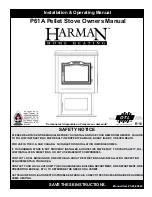
June 9, 2017
7061-196H
15
Explorer II
1. Creosote (Chimney) Cleaning
• Frequency:
Every 2 months during heating season or
as recommended by a certified chimney sweep; more
frequently if chimney exceeds or is under 14-16 ft.
(measured from bottom of appliance)
• By:
Certified Chimney Sweep
Remove all ash from the firebox and extinguish all hot embers
before disposal. Allow the appliance to cool completely.
Disconnect flue pipe or remove baffle and ceramic blanket
from appliance before cleaning chimney. Otherwise residue
can pile up on top of the baffle and ceramic blanket and
the appliance will not work properly. (See Baffle Removal
on
page 19
). Close the door tightly. The creosote or soot
should be removed with a brush specifically designed for
the type of chimney in use. Clean out fallen ashes from the
firebox.
It is also recommended that before each heating season
the entire system be professionally inspected, cleaned and
repaired if necessary.
Inspection:
Inspect the system at the appliance connection
and at the chimney top. Cooler surfaces tend to build creosote
deposits quicker, so it is important to check the chimney from
the top as well as from the bottom.
Formation and Need For Removal
: When wood is burned
slowly, it produces tar and other organic vapors which combine
with expelled moisture to form creosote.
The creosote vapors condense in the relatively cool chimney flue
of a newly-started or a slow-burning fire. As a result, creosote
residue accumulates on the flue lining. When ignited, this
creosote creates an extremely hot fire which may damage the
chimney or even destroy the house.
The chimney connector and chimney should be inspected
once every 2 months during the heating season to determine
if a creosote or soot buildup has occurred. If creosote or soot
has accumulated, it should be removed to reduce the risk of a
chimney fire.
a. The appliance and ashes must be completely cooled down
before using the Ash Removal System.
Reach down and
locate the ash removal door handle under the left side of the
appliance in the center.
Grasp the handle with your fingers
and place your thumb on the latch release (
Figure 15.1
). Press
the latch release inward. Keep the latch release pressed in and
lower the handle gently. Take your thumb off the release once
the handle is clear of the latch and guide the handle back until
it stops.
b. Remove cast iron cap from inside the firebox using tools
supplied. Clean ash down through the ash removal system
channel into the drawer below.
Inspect the top of the ARS door to ensure all ash has been
removed. You can rapidly move the ARS latch handle up
and down to help remove any ash from the door. Use
a small brush to clean off the top of the door if any ash
remains.
Be sure to replace the cap before operating the appli-
ance.
It is recommended to leave 1/4 to 1/2 inch (6-13mm)
of ash on the firebox floor to allow air to flow freely under
-
neath wood.
c. Close the door handle, you will hear a “click” when it closes.
Wear gloves to remove the drawer.
Dispose of the ashes
following the directions on
the next page.
2. Ash Removal System (ARS) Operating and Cleaning
• Frequency:
As necessary
• By:
Homeowner
• Gloves recommended
• May have sharp edges
CAUTION
Injury Risk.
WARNING
Fire Risk
Injury Risk
Make sure Ash Removal System door is sealed tight
against the gasket.
Air leakage may cause:
• Over-fire condition.
• Flame and/or smoke spillage.
• Wood to burn too fast.
Figure 15.1
B. General Maintenance
Fire Risk.
• Do not use chimney cleaners or flame colorants
in your appliance. Will corrode chimney pipe.
WARNING
WARNING
Fire Risk.
Prevent creosote buildup.
• Inspect chimney connector and chimney once every
two months during heating season.
• Remove creosote to reduce risk of chimney fire.
• Ignited creosote is extremely HOT.














































